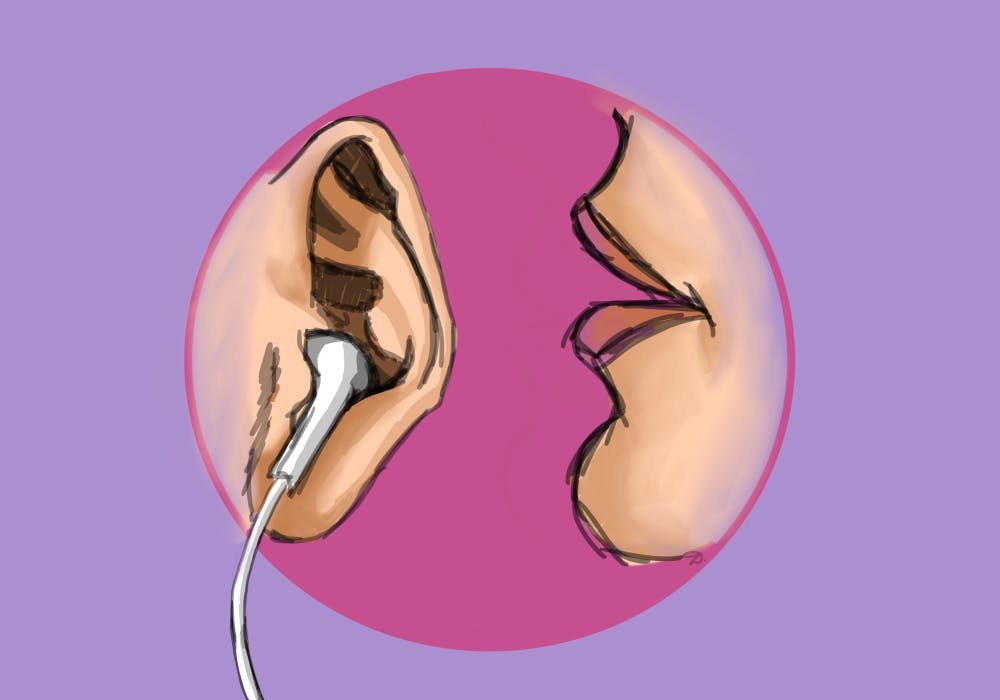I am an ASMR junkie. My love affair began one fateful night, when my insomnia was in high gear. I'd been hearing about ASMR and its sleep–inducing effects, but I'd never actually watched a full video. That night, I watched an hour–long compilation and although it didn’t help me sleep, it did make me feel safe and relaxed.
With that one click, ASMR invaded my YouTube recommendations. The following day, I discovered fried chicken–eating ASMR and fell in love. The beautiful crunch was music to my ears. I had nothing in my mouth, but I started to chew along.
In short, ASMR—Autonomous Sensory Meridian Response—is a tingly feeling that one can experience, often caused by quiet sounds known as triggers. Instagram revolutionized ASMR for me. Floral foam crushing, bath bombs fizzing, soap carving, and hair snipping—these are only a few of the ASMR techniques that fill my feed. Some others that keep me alive and thriving include: tire crushing, chalk chopping, hydraulic pressing, shredding, food making, Bob Ross, zen garden, Cardi B, and hate comments.
I'm curious to understand why ASMR has the effects it has on my brain. Why does it make me feel like a knot inside me immediately loosens up after watching a clip or two?
Investigating ASMR revealed there is currently little research on it. The name was coined in 2010, and its first peer–reviewed research study was published in 2015. The data found from surveying 475 people illustrated temporary improvements in symptoms of depression and chronic pain in those who engage in ASMR. The study also proposed a link between ASMR and synesthesia, a phenomenon in which one sense is connected to another.
Just a couple months ago, researchers from the University of Sheffield published a study that ASMR could be associated with reduced heart rates. The study found that those who experience ASMR showed significantly greater reductions in their heart rates when watching ASMR videos (an average decrease of 3.14 beats per minute) compared to those who do not. They also showed significant increases in positive emotions including relaxation and feelings of social connection.
Professor of biopharmaceutical sciences at Shenandoah University Craig Richard suggests that the science behind ASMR can be tied to our experience as infants. Because sight is least developed when a newborn is born, parents show love using coddling, stroking and other sensations. People watching ASMR videos, particularly ones involving speech, can get tingles and feel relaxed because it may recall the personal attention and care that they received as a child.
This brings up the provocative idea that doctors and psychologists may one day be able to “elicit some of those biochemical experiences associated with love—through a video with a stranger.”
After investigating, I acquired a deep appreciation for ASMR. It was time for me to contribute to the community and the research, and what better way to contribute than to make my own video and get my friends to review it. For ASMR, I put aside my fear of being on camera and tested my limited videography skills.
As seen in the video, I am nowhere close to becoming an ASMRtist. My friends are too nice to tell me so, although one did admit that she couldn’t take me seriously. Out of seventeen friends, three said they did not experience relaxation but instead felt gross or anxious. The loud noises weirded them out, and one concluded that ASMR was not for her. Twelve described my ASMR using words like “satisfying,” “soothing,” “relaxing,” “comforting,” and “calming.” One brought up an interesting point: she has to be “in the zone” for ASMR to work on her.
Four of my friends mentioned that they use ASMR to help them fall asleep. To my surprise, the soap carving was not very popular—my tapping and whispering were the favorites. Five friends said they felt worried during the soap carving part. Two were anxious because the soap was never cut evenly, and the other three were nervous because I was aiming the knife towards myself (they were right to be nervous—I did end up getting a little cut). Three others said they felt hungry after watching. One was shaken up by my joint cracking, specifically my neck cracking, and beseeched me to do a live showing of all my cracking.
The fact that a handful of my friends use ASMR to help them fall asleep is wildly fascinating to me. The fact that some friends didn’t experience ASMR from my video and were instead repulsed by it also fascinates me. My little experiment with ASMR gave birth to a flock of questions. Why does ASMR work so effectively on some people and not on others? Are people just hopping on the bandwagon? Might it be the case that people who say they don’t experience ASMR just haven’t found their ASMR trigger? What happens in the brain for those who do experience ASMR?
I can’t count number the times ASMR has helped me get through the day. And it’s not just me. I’ve seen classmates watch ASMR just to get through an hour of lecture. Now, if I may, Bob Ross is waiting for me with his “happy little trees” and his beautiful soothing baritone voice.







